List of Santos-Dumont aircraft facts for kids
Alberto Santos-Dumont was a brilliant inventor and a true pioneer in aviation. He designed, built, and flew many different kinds of aircraft during his career. Imagine, he created everything from giant balloons and steerable airships (called dirigibles) to early monoplanes, biplanes, and even a helicopter! People who study his work believe he might have created even more flying machines than we know about.
Santos-Dumont's Amazing Aircraft
Here's a look at some of the incredible flying machines Alberto Santos-Dumont created:
| Model | Image |
|---|---|
1898 |
|
| Brésil (balloon) – This balloon was made of Japanese silk. It could hold about 113 cubic meters (4,000 cubic feet) of gas. Its very first flight was on July 4, 1898. | 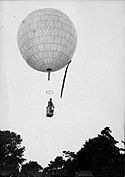 |
| L'Amérique (balloon) – This large balloon held 500 cubic meters (17,650 cubic feet) of hydrogen and was 10 meters (33 feet) wide. It could carry a few passengers, but it couldn't be steered. Santos-Dumont bravely flew it through storms and accidents. | 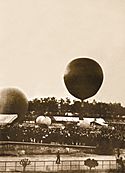 |
| No. 1 (airship) – This was Santos-Dumont's first steerable airship, flown on September 18, 1898. It was 25 meters (82 feet) long and 3.5 meters (11.5 feet) wide, holding 180 cubic meters (6,350 cubic feet) of gas. It had a small engine that powered a propeller. It flew well, but its inner air bag (called a ballonet) was too small, causing the airship to lose its shape and crash on its second flight. | 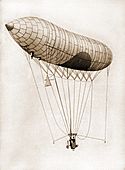 |
1899 |
|
| No. 2 (airship) – This airship was a bit bigger than No. 1, with a capacity of 200 cubic meters (7,060 cubic feet). During its first test on May 11, 1899, rain cooled the hydrogen inside, making it shrink. The airship folded in half and was blown into trees by a gust of wind. It was too damaged to be fixed. |  |
| No. 3 (airship) – This airship was shorter and wider than the earlier ones. Santos-Dumont hoped this design would help it keep its shape better. It was 20.11 meters (66 feet) long and 7.47 meters (24.5 feet) wide, holding 500 cubic meters (17,650 cubic feet) of gas. It used coal gas instead of hydrogen. Its first flight was on November 13, 1899. |  |
1900 |
|
| No. 4 (airship) – No. 4 was 39 meters (128 feet) long and 5.1 meters (16.7 feet) wide, with a gas capacity of 420 cubic meters (14,830 cubic feet). It had a different shape and a new engine. Santos-Dumont sat on a bicycle seat to steer it! He also started using hydrogen again, which he could now make himself. |  |
1901 |
|
| Le Fatum (balloon) – This balloon was built for experiments. It was 7 meters (23 feet) tall and held 310 cubic meters (10,950 cubic feet) of gas. Its first flight was on May 30, 1901. | 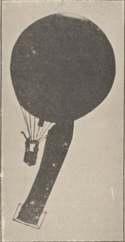 |
| No. 5 (airship) – Santos-Dumont built No. 5 to try and win the Deutsch de la Meurthe prize. This prize was for flying from Saint-Cloud to the Eiffel Tower and back in under 30 minutes. It had a long, triangular basket and used thin piano wires to reduce drag. It was powered by a 12 horsepower engine.
On August 8, 1901, during a prize attempt, the airship lost hydrogen and its engine stopped. It drifted back towards the Eiffel Tower and crashed onto the roof of a hotel. Santos-Dumont was rescued by firefighters, but the airship was completely destroyed. |
 |
| No. 6 (airship) – Santos-Dumont quickly built No. 6 after No. 5 was destroyed. It was similar but a bit larger, 22 meters (72 feet) long, and held 622 cubic meters (21,960 cubic feet) of gas. On October 19, 1901, he successfully flew it to the Eiffel Tower and back, winning the Deutsch de la Meurthe prize! |  |
1902 |
|
| No. 7 (airship) – This airship was designed for speed competitions. It was 50 meters (164 feet) long and 7.92 meters (26 feet) wide, holding 1260 cubic meters (44,500 cubic feet) of gas. It had a powerful 60 horsepower engine and two propellers. Sadly, it was damaged before a big competition, so it couldn't compete. |  |
| No. 8 (airship) – Some people thought Santos-Dumont skipped "No. 8" because he was superstitious. However, records show a No. 8 was built. It was a copy of No. 6, made for someone else, and only flew once before being taken apart. | |
1903 |
|
| No. 9 Baladeuse – Santos-Dumont built this as the smallest practical airship. It was later made a bit larger, holding 261 cubic meters (9,220 cubic feet) of gas. This airship was also bought by Edward Boyce. |  |
| No. 10 (airship) – Also called the Omnibus, this huge airship was meant to carry twelve passengers plus the pilot and another crew member. It was 48 meters (157.5 feet) long and 8.5 meters (27.9 feet) wide, with a capacity of 2010 cubic meters (71,000 cubic feet). It only made test flights. |  |
1905 |
|
| No. 11 (balloon) – No. 11 was a steerable balloon, 34 meters (111.5 feet) long, with a volume of 1,200 cubic meters (42,370 cubic feet). It had a 16 horsepower engine and could carry five people. An American bought this one. | |
| No. 12 (helicopter) – This was Santos-Dumont's helicopter design. It had two large rotors, each 6 meters (19.7 feet) wide, made of silk stretched over bamboo. It was powered by a 25 horsepower engine. | 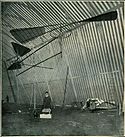 |
| No. 13 (airship) – This was a very unusual aircraft! It had a large, oval hydrogen balloon on top and a smaller, cone-shaped air balloon underneath. The air in the bottom balloon could be heated. Sadly, it was destroyed in its hangar during a storm. | 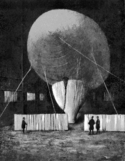 |
| Nº 14-a (airship) — This airship was 41 meters (134.5 feet) long and 3.4 meters (11.2 feet) wide, with a 14 horsepower engine. It made a short flight on June 12, 1905. |  |
| Nº 14-b (airship) — This was a changed version of the 14-a because the first one wasn't stable enough. It was 20 meters (65.6 feet) long and 6 meters (19.7 feet) wide, with a 16 horsepower engine. It was tested in August 1905. |  |
1906 |
|
| Oiseau de Proie (14-bis) (airplane) — Created in June 1906, this airplane was first attached to the No. 14 airship, which is why it got the name "14-Bis" (meaning "14-encore" or "14-second"). |  |
| Oiseau de Proie I (airplane) — This airplane was 4 meters (13 feet) high, 10 meters (33 feet) long, and had a wingspan of 12 meters (39 feet). It had two wheels and a 24 horsepower engine. Santos-Dumont tested it by pulling it with a donkey to check the controls. Later, a small rear wheel was added. He kept improving it, and by September 1906, it could reach 35 km/h (22 mph) on the ground and even jump 7 meters (23 feet) into the air! |  |
| Deux Amériques (balloon) – This was a spherical balloon with horizontal propellers. Santos-Dumont used it in the famous Gordon Bennett Cup race. |  |
| Oiseau de Proie II (airplane) — This was an improved version of the previous model, with varnished wings and no rear wheel. On October 23, 1906, it made history! It took off and stayed in the air for 6 seconds, reaching a height of 3 meters (10 feet) and flying 60 meters (197 feet). This flight won him the Archdeacon Award, proving that a heavier-than-air machine could fly on its own power. |  |
| Oiseau de Proie III (airplane) — In November 1906, this version flew for 220 meters (722 feet). It had special "octagonal airfoils" between its wings. |  |
1907 |
|
| Oiseau de Proie IV (airplane) — This version flew 30 meters (98 feet) in April 1907. Sadly, on April 4, after flying about 50 meters (164 feet), it crashed and was destroyed. |  |
| No. 15 (aeroplane) – This was a biplane (two wings) with the engine mounted above the top wing. It had very long, narrow wings. It was damaged during ground tests and, even after repairs and a more powerful engine, it never flew successfully. |  |
| No. 16 (hybrid airship) – This was a unique "hybrid" aircraft, meaning it combined features of an airship and an airplane. It was 21 meters (69 feet) long and 3 meters (9.8 feet) wide. It couldn't fly just by floating; it needed its wings to create lift. It was tested without success on July 8, 1907. |  |
| Nº 17 — Similar to No. 15, this airplane had a powerful 100 horsepower engine but was never tested. It was known as "La Sauterelle," which means "The Grasshopper." | |
| No. 18 – This wasn't an aircraft, but a "hydro-flotteur," which was a propeller-driven boat designed to skim across the water. It had a powerful V-16 engine and rested on a main float with smaller floats on the sides for stability. |  |
| Nº 19 Demoiselle – This was the first version of Santos-Dumont's famous "Demoiselle" series of small, lightweight airplanes. |  |
| Nº 19Bis Demoiselle— Built in November 1907, this version had stronger wings and an engine placed underneath. It was never tested. | |
1908 |
|
| Nº 20 Demoiselle — This was an improved version of No. 19. Many people consider it to be the first truly practical ultralight aircraft because it was so small, simple, and easy to fly. |  |
1909 |
|
| Nº 21 Demoiselle — This model was similar to the previous one but used a different engine. |  |
| Nº 22 Demoiselle - This final version of the Demoiselle used all the lessons Santos-Dumont had learned from his earlier designs, making it a very refined and successful small airplane. |  |

